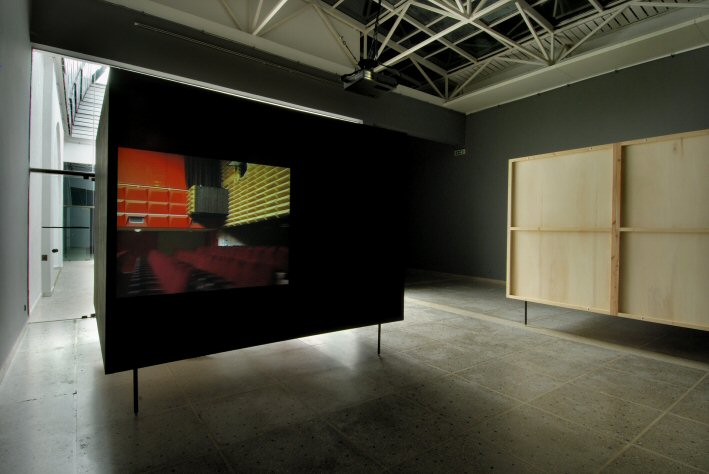Artist:
Andreas Fogarasi (born 1977 in Vienna, Austria; lives and works in Vienna).
Description:
“From June to November 2007 the Hungarian Pavilion of the 52nd Venice Biennale showcases Andreas Fogarasi’s project Kultur und Freizeit (Culture and Leisure) curated by Katalin Timar. The project focuses on cultural peripheries and the separation of the locations of popular culture, a phenomenon affecting and concerning nowadays all Europe.
“Andreas Fogarasi (b. 1977)… will show his single-channel video series about the present of cultural centres in Budapest in separate black boxes designed exclusively for the Hungarian Pavilion of the Venice Biennale.
“Entering these micro-cinemas on the shorter side of the black boxes halved and somewhat diverging viewers take place on the benches and watch six [films] about cultural centers in Budapest, 4 to 12 minutes long each. Rather than being straightforward documentaries these short films focus on the global phenomenon of the survival and isolation of clubs, cultural centers, and public spaces on the peripheries of high-culture instead. Fogarasi’s images, slow-motion, emphatically impersonal, loitering on architectural details once considered to be so choice, research the situation of these cultural sites which have slowly become the islands of subcultures [and] alternative satellite cultures recently. Through their history and role these cultural centers, locations of the democratization of culture centrally controlled and supervised in Hungary, would connect to the past political system of the country, internationally though they date back to the nineteenth-century conception of workers’ educational societies. In the shadow of downtown commercial and cultural plazas they have been pressed on the social and cultural peripheries these days.”
—”Andreas Fogarasi,” Galerie Transit.
“The audience’s experience of Kultur und Freizeit is very precisely dictated: projecting out from the gallery wall is a large, black cube housing a bench and a wooden viewing funnel; once seated inside this peepshow-like milieu, the viewer’s position and gaze are fixed. This elegant construction feels like a scaled-down version of the many theatrical arenas featured in Fogarasi’s film. The children’s party scene, for instance, takes us into one of Budapest’s many cultural centers. The Hungarian capital has a large, decentralized network of these state institutions, which were built from the 1950s onwards as successors to the workers’ clubs of the nineteenth century. In Kultur und Freizeit, Fogarasi, who was born in Vienna to Hungarian parents, depicts several of these cultural centers dating from different periods. His perspective is essentially a sympathetic one, for although these institutions served as arenas in which workers could be politically influenced, they also provided scope for counterculture and, in isolated cases, even became hotspots for the artistic avant-garde. As in previous exhibitions, Fogarasi addresses culture’s position at the interface between the economy and the state. Who, he posits, creates publics and how? Which hidden ideologies go hand in hand with acculturation? And to what extent does the art world function as part of the entertainment industry?”
—Nicole Scheyerer, review of Andreas Fogarasi, trans. Nicholas Grindell, Frieze, April 15, 2007.


